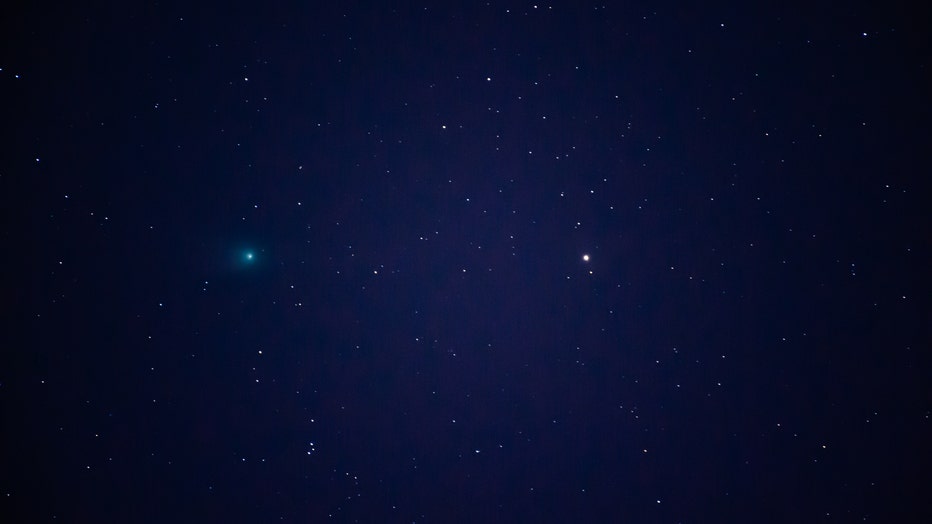Green comet sighting: Here's when to see this celestial view unlikely to return for millions of years
Astronomers discovered a new comet just in time for its closest approach to Earth in February. However, after this encounter, comet C/2022 E3 won't be coming by Earth for a very long time.
Comet C/2022 E3 ZTF is fast approaching the closest point to Earth in its orbit, expected in late January and early February. This flyby will be a rare occurrence when a comet can be seen by the naked eye without the aid of a telescope or binoculars.
This celestial sighting is a bit like space-speed dating. Astronomers only just learned of its existence, and it will be gone before we know it, possibly never to return.
The comet last made a close approach about 50,000 years ago.

Comet C/2022 E3 (ZTF) in the sky of Molfetta before sunrise around 6.00 AM on January 24, 2023.Comet C/2022 E3 (ZTF) continues to approach Earth. He last passed on Earth 50,000 years ago, Neanderthals still lived in our latitudes. The comet will be c
Astronomers at the National Science Foundation's Zwicky Transient Facility (ZTF) in California first detected this moving object out in the solar system on March 2, 2022.
‘A needle in a haystack:’ How comets are discovered
The Zwicky Transient Facility looks for space objects such as asteroids and comets using two different methods, according to Thomas Prince, astronomer and director of the W.M. Keck Institute for Space Studies at Caltech.
Using the telescopes at Caltech's Palomar Observatory, a 50-square-degree area of the sky is scanned nightly, observing the entire sky accessible to Southern California every two nights.
A machine learning algorithm developed by Frank Masci of Caltech then looks for "fuzzy" objects that might be moving comets, or it compares multiple images of the same object to follow its line of motion.
RELATED: Bright green comet may become visible to naked eye later this month
Prince said it's essentially "looking for the needle in the haystack."

Five images taken by the Zwicky Transient Facility at Caltech show Comet C/2022 E3 (ZTF) moving. (Image credit: Zwicky Transient Facility/National Science Foundation)
"Roughly, in the night sky that's accessible to us, there are about one and a half billion stars," Prince said. "You know, the 300,000th star is not that interesting. But then what we have to do is use computer techniques to find the interesting objects."
The software tracking a moving object was how Caltech astronomer Bryce Bolin of Caltech discovered Comet C/2022 E3 (ZTF) in March.
RETIRED NASA SATELLITE CRASHES INTO EARTH OFF ALASKA'S COAST
In the five ZTF images taken about 3.5 minutes apart above, you can see the comet on the move.
After reporting the possible comet to the Minor Planet Center, a few weeks later, it was confirmed through multiple observations from different observatories and received its provisional name Comet C/2022 E3 (ZTF).
It's possible the comet could get a jazzier name. However, that process goes through the International Astronomical Union and takes some time.
"We'd love for this one to be called Comet ZTF," Prince said, hoping it catches on.
What can we expect to see from Comet C/2022 E3?
Comets orbit the sun and come from the ice-coated organic leftovers of our solar system beyond Pluto. According to NASA, these fossils of our solar system are sometimes known as "dirty snowballs."
On Jan. 12, Comet C/2022 E3 (ZTF) reached perihelion - its closest approach to the sun. This made a good time to begin looking for the comet at night.
The comet's closest approach to Earth happens on Feb. 1, but it is already visible with the help of a telescope and will continue to be visible through mid-February. At its nearest, the harmless comet will be about 26 million miles from Earth.
Prince offered a few suggestions if you want to begin looking for the approaching comet.
"It has to be a dark sky and moonless in the sky," Prince said.
Now that the January full moon has come and gone, Prince said to try and get to an area with as little light pollution as possible, away from city lights.
Even though this is considered a bright "naked-eye" comet, using a pair of binoculars will definitely help. To find the comet, look for a bright fuzzy object.
"It will distinguish itself probably from other stars because it will look a little bit fuzzy compared to other stars," Prince said.
With telescopes, astronomers are already spotting the bright-green comet and its faint tail.
Prince offered another trick to spotting the comet. On Feb. 10, the comet will be about 1.5 degrees from Mars.
"Mars is very bright, and you can just look within one degree around Mars and maybe be able to see it," Prince said.
How rare is a naked-eye comet visible to Earth?
Comets zoom by Earth all the time. What makes ZTF's recent comet discovery unique is that it is bright and close enough to be seen without a telescope.
When you hear "naked-eye" comet, a few others come to mind, including Comet Hale-Bopp's flyby in 1997 and Halley's Comet which astronomers have documented for 2,000 years. Halley's Comet will make another close flyby of Earth in 2061 during its 76-year orbit of the sun.
Comet NEOWISE, discovered by NASA's Near-Earth Object Wide-field Infrared Survey Explorer (NEOWISE), was observed all over the world and by astronauts on the International Space Station in 2020, according to NASA.
When will ZTF Comet C/2022 E3 return?
ZTF's Comet was initially thought to make another close pass by Earth in 50,000 years. Astronomers now estimate it could be a few million years before another flyby.
University of Maryland astronomer and ZTF Survey member Ye Quanzhi said scientists would have a better idea of its orbital period after it's heading outbound to see how its passage through the inner solar system messes with the comet's orbit.
"It's safe to say that the comet won't be back anytime soon," Quanzhi told FOX Weather via email.
If you miss it, there will be more opportunities in your lifetime. According to NASA, there are more than 3,700 known comets.
'LOSS OF SIGNAL:' NASA SUCCESSFULLY CRASHES DART SPACECRAFT INTO ASTEROID FOR PLANETARY DEFENSE
Finding and tracking space objects like comets are important for several reasons, Prince said.
"One is just the fascination with the night sky and the fact that for large numbers of people, this is exciting to see an object that's traveling through our solar system and traveling close enough to the Earth that we can see it," he said.
The second is knowing where these objects are to predict a potential collision with Earth for planetary defense.
"Just accumulating as much knowledge as we can about these rather large rocks that are flying around the solar system," Prince said.
NASA completed its first planetary defense test mission in September 2022 by crashing a spacecraft into a small asteroid orbiting another asteroid, effectively changing its orbit by about 32 minutes.

